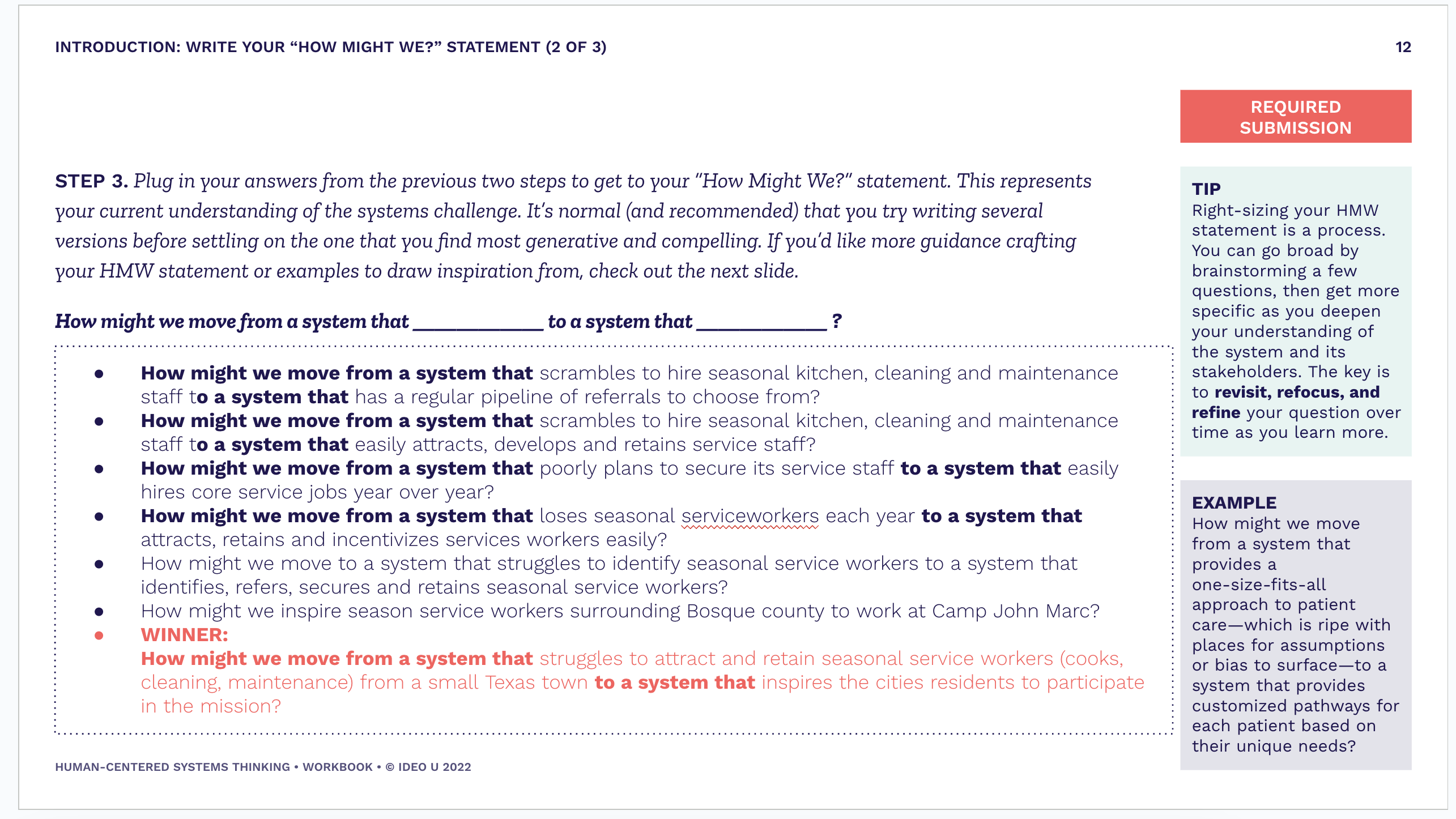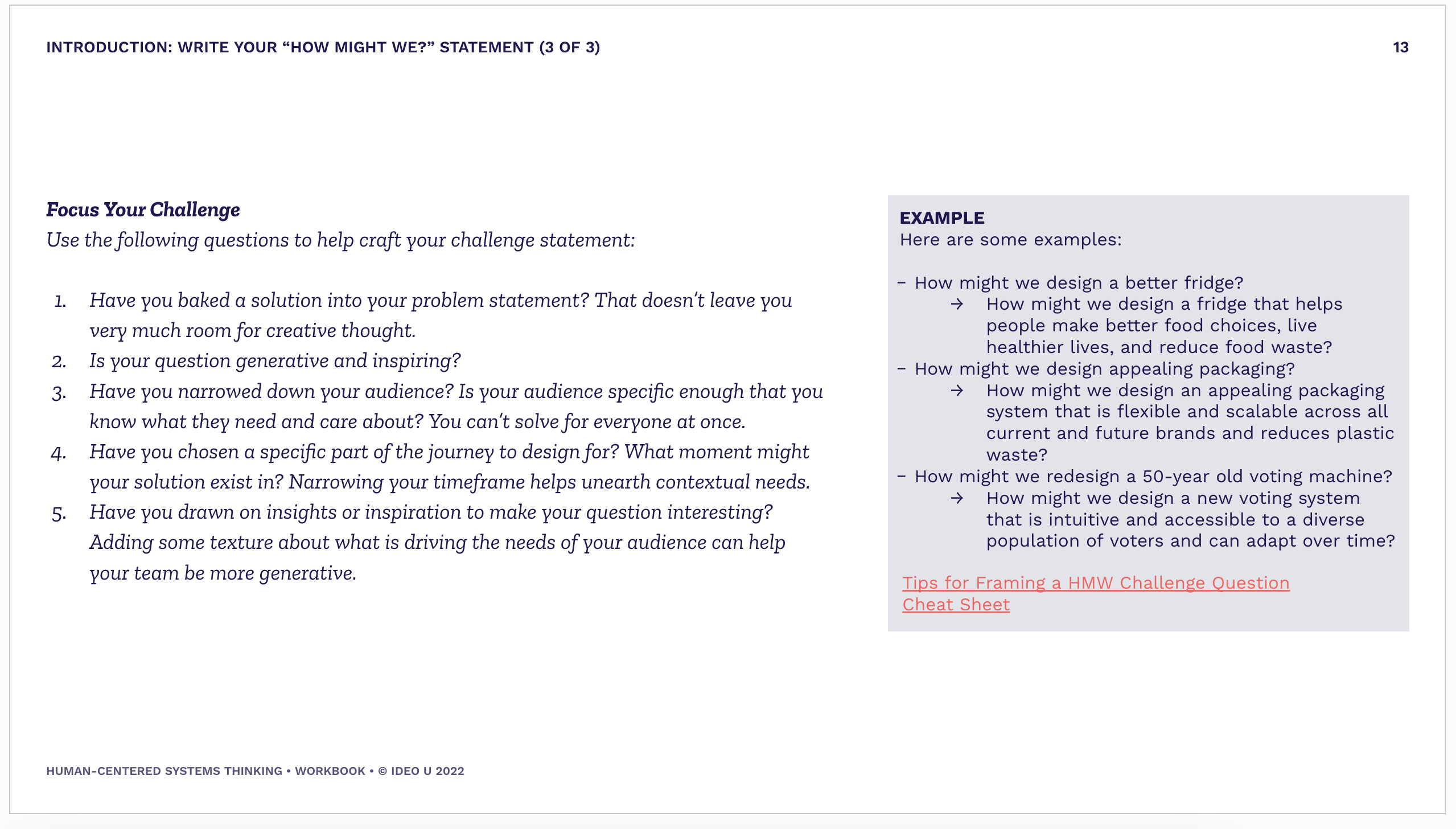April 25, 2023
🌌 IDEO Human-Centered Systems Thinking Course
I took this course shortly after losing my job at Amazon — I wish I had taken it years ago. I have always used elements of systems thinking, but what seperates this course is that you harness the power of A) systems thinking: seeing the connections and interactions between people of a system B) human-centered design: empathizing with people & their experiences in order to build creative solutions in service of said people.
Below I will describe some of the top learnings.
LEARNING #1
Excellent Course Overview
The instructors provided all the context needed to understand the direction of the course while doubling as a planning resource.

LEARNING #2
Zooming-In & Zooming-Out in Interviews
Zooming-Out
What questions can I ask to understand how a person experiences a system?
What questions can I ask to understand how a person experiences a system?
- What is your day to day work like?
-
What do you enjoy most about your role?
-
What gets you out of bed in the morning?
-
What are some of the obstacles you face?
-
What barriers, if removed, would make your day better?
- How do you make decisions?
Zooming-In
What questions can I ask to situate the person in the larger system?
What questions can I ask to situate the person in the larger system?
- Who do you work with?
- Who do you not work with?
- Who do you wish you collaborated with?
- How do you interact or wish to interace with?
- Who should I talk to next?
Recap Post-Interviews
What did I lea
What did I learn about how the interviewee interacts with other stakeholders in the system?

LEARNING #3
Articulating How Might We’s?
Defining the undesired qualities occuring in the current state and the desired outcomes of the future state.
Learning: start with VERBS as the produce more solutions that NOUNS (just one).
Step 1: Describe Current Conditions
- What are the problematic qualities of the current state of the system?
- What problem are we trying to solve?
- What undesirable outcome does the system produce?
Step 2: Frame Ideal Future State
- What are the ideal dynamics of the future state of the system?
- What outcomes do we aspire to see?
- Who are you working in serivce of?
Step 3: Crafting HMW’s to Guardrail Problem to Solve
- Generate 5-10
- How might we move from a system that struggles to attract and retain seasonal service workers (cooks, cleaning, maintenance) from a small Texas town to a system that inspires the cities residents to participate in the mission?
Considerations for HMWs:
- Have we baked a solution into the problem statement? This doesn’t leave much room for creative thought.
- Is the question generative and inspiring?
- Have we narrowed down our audience? Is your audience specific enough that you know what they need and care about?
- Have you chosen a specific part of the journey to design for? What moment might our solution exist? Narrowing the timeframe will help unearth contextual needs.
- Have we drawn on insights or inspiration to make our question interesting? Adding some texture about what is driving the needs of our audience can help us be more generative.



LEARNING #4
Types of Systems Maps
The 3 most common systems maps. They help serve as relationship between elements such as people, process, behaviors and mindset.
Value of Systems Maps:
- Make sense of complex situations
- Uncover the root causes of problems
- Create a shared understanding with stakeholders.
Types of Systems Maps:
- Network Map - visualize interconnections in a complex network, including nonlinear relationships and underlying dynamics.
- Process Map - visualize complex processes to view core moments that matter.
- Problem Map - visualize the root caise of a problem, esp. beneath the surface.

Considerations for Network Map:
The more you can foster new interactions and relationships the more powerful leverage points become.
![]()
- ALINGMENT: What is the strenght of alignment between people? This can be based on priorities, incentives, perspectives and understanding.
- COMMUNICATION: What are the lines and directions of communication? These can be formal or informal ways on communication.
- POWER: what are the sources of power within the system? This can be formal authority or ability to influence decision makers.
- INFLUENCE: what is the degree and nature of influence? This can be based on things like money, emotion, knowledge, visibility, trust, etc.
- VALUE: what are the exchanges of value? This can be anything like time, money, data, resources, info, etc.
The more you can foster new interactions and relationships the more powerful leverage points become.
- Look for gaps, pain points or hot spots of influence
- What are hidden or missing connections?
- What are the hubs of knowledge, power or influencing?

Considerations for Process Map:
The further upstream you can intervene the more powerful leverage points become.
![]()
- Look at the 3-5 core moments
- What are the overlaps and common touchpoints?
- Are there gaps? Are there parts of the process that are siloed or missing steps?
- Are there parts of the process where people are disadvantaged because the don’t have visibility?
The further upstream you can intervene the more powerful leverage points become.
- Look for situations where the process is slow, blocked or diverted.
- What are the common touchpoints, overlaps or gaps?

Considerations for Problem Map:
In the Iceberg model, the closer you can move below, the more powerful leverage points become.
![]()
- Does the problem involve an important issue?
-
Is the problem a chronic occurence, not a one-time event?
-
Is the problem familiar to you with a known history?
- Have others tried to solve the problem but unsucessfully?
In the Iceberg model, the closer you can move below, the more powerful leverage points become.
- Look at the underlying structures and mindsets to influence behavior.
- What are the tangible or intangible things that contribute to behavior?

LEARNING #5
Post-Interview Reframe
Considerations when making sense of new data.



LEARNING #6
Redesign the System: Levers of Design
Brainstorming tactics.
Round 1: Generate Ideas based on Toast Framing Inspiration
Round 2: Take Someones Idea and Build off of it
Reframe for Round 2
- Look at the problem from a human perspective
- Look at the problem from multiple stakeholders perspetives
- “widen your aperture”
- Look at other players in your industry
- Look at the natural world for inspiration



Levers of Design to Consider as Ideation Principles:
- Strategy - align around a common direction
- Structure - where authority resides in each direction
- Process - direct the flow of activity
- Talent - grow mindsets and skills
- Incentives - giving rewards
- Infrastructure- designing within the tools
Prototyping: prototyping to learn more about the system.
Prototypes help you do 3 things:
- Explore hidden or hard to see connections in a complex environment. Probe the system in a tangible way to uncover gaps and connections.
- Experience the system to understand how it feels. Build a shared understanding by helping people experience the system in similar ways — both functionally and emotionally. Set the conditions for a compelling “aha” moment that shifts behavior and perspectives.
- with the system to see how it repsonds to change. Change in one part of the system can produce unexpected behaviors in another. When provoking a response, observe the results and refine accordingly.





LEARNING #6
Moving Forward & Measuring Impact
Bringing people along the journey
Quantitative metrics can help you to track your progress against defined targets
Qualitative feedback from people can give you deeper insight into how your solution is working or not working and why
Measuring Impact in Systems
-
First, what are the key mindsets and behaviors that you hope to see in the future? Action: Clarify your objectives and desired outcomes [short, middle, long-term]
-
Second, what are some possible indicators that you're on track towards these mindsets and behaviors? Action: Consider what data you'll need to develop a set of measures so we know if we are successful or not. Look for indicators that will help you measure shifts in people's knowledge, mindsets, or behaviors. And consider what you can actually track.
-
And third, what methods will you use to track your progress over time? Action: Determine how you'll gather this data and how often? Who will use it? How will it help us make decisions? Look beyond the obvious revenue, etc
The trick is to find a balance between objective (or conventional) measures and more subjective (or unconventional) ones. The latter tend to be small, nuanced indicators of how people's mindsets, behaviors, and relationships are changing. They can forecast the story before it happens or provide an early indication that things are moving in the right direction.
Next Steps:
- Desired: Mindsets & behaviors
- Action to take:
- Indicators will be

